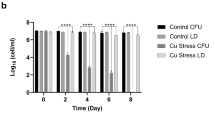Abstract
Resazurin (RZ) is a weakly fluorescent blue dye and can be reduced irreversibly to highly fluorescent pink resorufin (RF) that is reduced reversibly to colorless dihydroresorufin (hRF) by photo, deoxygenation, chemical reaction and reductive organic compounds produced through cell metabolism. Because of the reliable and sensitive fluorescence-color change and noninvasive features, RZ has been used widely as a redox indicator in cell viability/proliferation assays for bacteria, yeast, and mammalian cells. However, RZ is used rarely for physiological characterization of marine microorganisms. Here, we developed a custom-made irradiation and absorption-analysis device to assess the reducing capacity and physiologic status of marine bacterial cultures. We measured the absorption spectra of RZ, RF, and hRF in the presence of the reducing compound Na2S and under visible-light irradiation. After establishing appropriate parameters, we monitored the color changes of RZ and its reduced derivatives to evaluate the coherence between reducing capacity, bioluminescence and growth of the deep-sea bacterium Photobacterium phosphoreum strain ANT-2200 under various conditions. Emission of bioluminescence is an oxidation process dependent upon cellular reducing capacity. Growth and bioluminescence of ANT-2200 cell cultures were impeded progressively with increasing concentrations of RZ, which suggested competition for reducing molecules between RZ at high concentration with reductive metabolism. Therefore, caution should be applied upon direct addition of RZ to growth media to monitor redox reactions in cell cultures. Analyses of the instantaneous reduction velocity of RZ in ANT-2200 cell cultures showed a detrimental effect of high hydrostatic pressure and high coherence between the reducing capacity and bioluminescence of cultures. These data clearly demonstrate the potential of using RZ to characterize the microbial metabolism and physiology of marine bacteria.
Similar content being viewed by others
References
Afkhami A, Safavi A, Massoumi A. 1991. Catalytic Spectrophotometric determination of an ultra-trace amount of lead by reduction of resazurin by sodium sulfide. Analytical Letters, 24(9): 1 643–1 655, https://doi.org/10.1080/00032719108053000.
Al Ali B, Garel M, Cuny P, Miquel J C, Toubal T, Robert A, Tamburini C. 2010. Luminous bacteria in the deep-sea waters near the ANTARES underwater neutrino telescope (Mediterranean Sea). Chemistry and Ecology, 26(1): 57–72, https://doi.org/10.1080/02757540903513766.
Barnes S, Spenney J G. 1980. Stoichiometry of the nadh, oxidoreductase reaction for dehydrogenase determinations. Clinica Chimica Acta, 107(3): 149–154, https://doi.org/10.1016/0009-8981(80)90442-8.
Bueno C, Villegas ML, Bertolotti S G, Previtali C M, Neumann M G, Encinas M V. 2002. The excited-state interaction of resazurin and resorufin with aminesin aqueous solutions. Photophysics and photochemical reaction. Photochemistry and Photobiology, 76(4): 385–390, https://doi.org/10.1562/0031-8655(2002)0760385TESIOR2.0.CO2.
De Jong D W, Woodlief W G. 1977. Fluorimetric assay of tobacco leaf dehydrogenases with resazurin. Biochimica et Biophysica Acta (BBA) — Enzymology, 484(2): 249–259, https://doi.org/10.1016/0005-2744(77)90081-X.
Dunlap P V, Kita-Tsukamoto K. 2006. Luminous bacteria. In: Dworkin M, Falkow S, Rosenberg E, Schleifer K H, Stackebrandt E eds. The Prokaryotes. Volume 2: Ecophysiology and Biochemistry. Springer, New York, NY. p.863–892, https://doi.org/10.1007/0-387-30742-7_27.
Kowaltowski A J, 2019. Strategies to detect mitochondrial oxidants. Redox Biology, 21: 101065, https://doi.org/10.1016/j.redox.2018.101065.
Martini S, Al Ali B, Garel M, Nerini D, Grossi V, Pacton M, Casalot L, Cuny P, Tamburini C. 2013. Effects of hydrostatic pressure on growth and luminescence of a moderately-piezophilic luminous bacteria Photobacterium phosphoreum ANT-2200. PLoS One, 8(6): e66580, https://doi.org/10.1371/journal.pone.0066580.
Neumann M G, Schmitt C C, Previtali C M, Bertolotti S G. 1996. Photoreduction of resazurin in the presence of aliphatic amines. Dyes and Pigments, 32(2): 93–99, https://doi.org/10.1016/0143-7208(96)00020-4.
Nijvipakul S, Wongratana J, Suadee C, Entsch B, Ballou D P, Chaiyen P. 2008. LuxG is a functioning flavin reductase for bacterial luminescence. Journal of Bacteriology, 190(5): 1531–1538, https://doi.org/10.1128/JB.01660-07.
O’Brien J, Wilson I, Orton T, Pognan F. 2000. Investigation of the Alamar Blue (resazurin) fluorescent dye for the assessment of mammalian cell cytotoxicity. European Journal of Biochemistry, 267(17): 5 421–5 426, https://doi.org/10.1046/j.1432-1327.2000.01606.x.
Porcal G V, Altamirano M S, Bertolotti S G, Previtali C M. 2011. Organized media effect on the photochemical deoxygenation of resazurin in the presence of triethanolamine. Journal of Photochemistry and Photobiology A: Chemistry, 219(1): 62–66, https://doi.org/10.1016/j.jphotochem.2011.01.018.
Rampersad S N. 2012. Multiple applications of Alamar Blue as an indicator of metabolic function and cellular health in cell viability bioassays. Sensors, 12(9): 12347–12360, https://doi.org/10.3390/s120912347.
Safavi A, Afkhami A, Massoumi A. 1990. Spectrophotometric catalytic determination of ultra-trace amounts of selenium based on the reduction of resazurin by sulphide. Analytica Chimica Acta, 232: 351–356, https://doi.org/10.1016/S0003-2670(00)81253-2.
Zhang S D, Santini C L, Zhang W J, Barbe V, Mangenot S, Guyomar C, Garel M, Chen H T, Li X G, Yin Q J, Zhao Y, Armengaud J, Gaillard J C, Martini S, Pradel N, Vidaud C, Alberto F, Médigue C, Tamburini C, Wu L F. 2016. Genomic and physiological analysis reveals versatile metabolic capacity of deep-sea Photobacterium phosphoreum ANT-2200. Extremophiles, 20(3): 301–310, https://doi.org/10.1007/s00792-016-0822-1.
Zhao B Z, Ranguelova K, Jiang J J, Mason R P. 2011. Studies on the photosensitized reduction of resorufin and implications for the detection of oxidative stress with Amplex Red. Free Radical Biology and Medicine, 51(1): 153–159, https://doi.org/10.1016/j.freeradbiomed.2011.03.016.
Author information
Authors and Affiliations
Corresponding authors
Additional information
Data Availability Statement
All data generated and/or analyzed during the current study are available from the corresponding author on reasonable request.
Supported by the National Key R&D Program of China (Nos. 2016YFC0302502, 2018YFC0309904, 2016YFC0304905), the NSFC of China (Nos. 91751202, 91751108, 41806174), the Sanya Municipality (Nos. 2018YD01, 2018YD02), and the CNRS for LIA-MagMC
Electronic supplementary material
Rights and permissions
About this article
Cite this article
Dai, J., Tang, H., Li, X. et al. Resazurin as an indicator of reducing capacity for analyzing the physiologic status of deep-sea bacterium Photobacterium phosphoreum ANT-2200. J. Ocean. Limnol. 39, 297–305 (2021). https://doi.org/10.1007/s00343-020-9301-8
Received:
Accepted:
Published:
Issue Date:
DOI: https://doi.org/10.1007/s00343-020-9301-8




